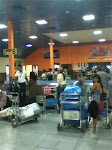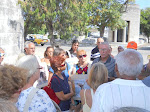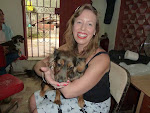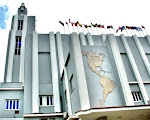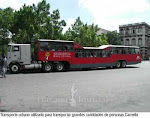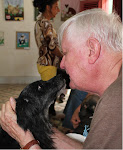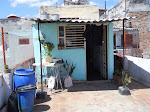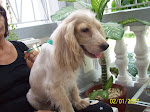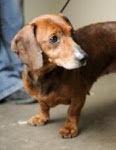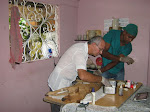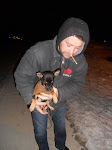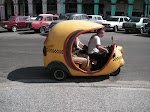Crossing the Street
When you see a dog out with his owner in the US, the dog is usually on a leash. I’ve always admired dog guardians who have such good control over their animals that they don’t need a leash, but I haven’t been that good at training mine. In Cuba leashes are rare, and yet dogs are numerous. I watched a family of three crossing a busy street near my hotel with their dog following them and, of course, no leash. I held my breath for the dog’s safety as they crossed the street, but he stayed right with his family, and he avoided any problems with cars.
Well, that’s OK for a family’s companion animal, but what about strays, you might ask. It turns out that strays still learn to get around on the streets without having families to follow. Three years ago when we rescued Aló Presidente on the streets of Vedado, he got our attention by following us. We were walking down the main artery of Vedado, a street with a wide parkway named Avenue of the Presidents. As we moved along, we crossed the side streets that that didn’t seem too dangerous. Aló followed us without hesitation. As we neared our hotel, we waited at the curb to cross to the wide parkway in the middle of the street. Aló stood near us and waited as if he had been our dog forever.
Finally the traffic stopped, and we stepped off to cross the crowded lanes. Aló didn’t look at the cars, he looked at us! He was still not quite fully grown, but he had already assimilated a critical survival rule for life in the city: If the humans feel it is safe to cross and start off, then it’s safe for a dog.
In Havana there are many more dogs on the streets than here in the US. Most dogs, owned or strays, quickly learn to trust people on crossing streets. I had an airline pilot friend who used to say, “There are old pilots and there are bold pilots, but there are no old, bold pilots. The same saying can be applied to city dogs, and the dogs running loose on Havana’s streets are living proof.
No other species exists in the world today that is so connected to human beings. It’s far more than a mutual admiration society—there are countless examples of how humankind and dogs serve and depend upon each other.
Les Inglis
Friday, May 28, 2010
Tuesday, May 25, 2010
The Havana Airport
On my first trip to Cuba, we arrived on time at the old terminal of Havana’s Jose Martí airport. That’s the one reserved for flights to and from the US. Havana has a modern airport terminal with jet ways and all the trimmings, but the old terminal for US flights is just one more little battle in the 50 year-old war of ideas between the Cuban and American governments. Christina and I were to be met by Thelma and taken to our hotel.
Well, we waited over an hour in a public area outside the terminal, and we never seemed to find Thelma. I made a pest of myself asking each woman if she was Thelma. Most of the time we just sat and watched the taxis come and go. I saw a skinny little dog walking in the street by the curb, and he looked pretty bad. He tried to scale the curb, and I could see he was pretty weak. Starvation, I thought, and I looked for something he could eat.
But all I saw was a candy stand, and it was surrounded by a bunch of people waiting for the lone clerk to help them. I waited in line for a while, and the little dog moved away until I couldn’t see him any more. The road to Hell is paved with good intentions, I thought, and I rejoined Christina looking for Thelma. Eventually we got a taxi and linked up with Thelma later. Also, eventually I learned the likely reason the little dog was there.
Every year 200,000 Cubans win a lottery run by the US Interests Section (a sort of embassy in Havana), and they get permission to emigrate to the US. They have to leave their possessions in the hands of the Cuban government, give up claims to their property, and show up at the airport with no more than they can carry or wear. It’s a tough price to pay to move to the US, but thousands have done it. It’s an even tougher price to pay for their pet animals, who can’t go with their families.
If the family can’t find a new home for their dog or cat, they may take it out to the airport to keep it to the last minute. Then the dog or cat is set free at the airport to face a very uncertain future. It’s cruel, it’s thoughtless, and it’s a big betrayal, but the number of strays that can be seen at the airport testify to two contrasting futures—that of the family, bright and hopeful about a new life in the US, and their pet’s facing loneliness, unfamiliar surroundings, strangers, and nothing to eat.
Nora Garcia, the President of Aniplant, Havana’s animal protection organization, militates against this thoughtlessness in her two weekly radio programs and one on television. People in Cuba often love their animals, and Nora’s public education about humane treatment has helped reduce the number of airport dogs, but it has not solved the problem. After all, she’s trying to instill a new ethic toward animals in an old and established culture.
Les Inglis
On my first trip to Cuba, we arrived on time at the old terminal of Havana’s Jose Martí airport. That’s the one reserved for flights to and from the US. Havana has a modern airport terminal with jet ways and all the trimmings, but the old terminal for US flights is just one more little battle in the 50 year-old war of ideas between the Cuban and American governments. Christina and I were to be met by Thelma and taken to our hotel.
Well, we waited over an hour in a public area outside the terminal, and we never seemed to find Thelma. I made a pest of myself asking each woman if she was Thelma. Most of the time we just sat and watched the taxis come and go. I saw a skinny little dog walking in the street by the curb, and he looked pretty bad. He tried to scale the curb, and I could see he was pretty weak. Starvation, I thought, and I looked for something he could eat.
But all I saw was a candy stand, and it was surrounded by a bunch of people waiting for the lone clerk to help them. I waited in line for a while, and the little dog moved away until I couldn’t see him any more. The road to Hell is paved with good intentions, I thought, and I rejoined Christina looking for Thelma. Eventually we got a taxi and linked up with Thelma later. Also, eventually I learned the likely reason the little dog was there.
Every year 200,000 Cubans win a lottery run by the US Interests Section (a sort of embassy in Havana), and they get permission to emigrate to the US. They have to leave their possessions in the hands of the Cuban government, give up claims to their property, and show up at the airport with no more than they can carry or wear. It’s a tough price to pay to move to the US, but thousands have done it. It’s an even tougher price to pay for their pet animals, who can’t go with their families.
If the family can’t find a new home for their dog or cat, they may take it out to the airport to keep it to the last minute. Then the dog or cat is set free at the airport to face a very uncertain future. It’s cruel, it’s thoughtless, and it’s a big betrayal, but the number of strays that can be seen at the airport testify to two contrasting futures—that of the family, bright and hopeful about a new life in the US, and their pet’s facing loneliness, unfamiliar surroundings, strangers, and nothing to eat.
Nora Garcia, the President of Aniplant, Havana’s animal protection organization, militates against this thoughtlessness in her two weekly radio programs and one on television. People in Cuba often love their animals, and Nora’s public education about humane treatment has helped reduce the number of airport dogs, but it has not solved the problem. After all, she’s trying to instill a new ethic toward animals in an old and established culture.
Les Inglis
The Havana Airport
On my first trip to Cuba, we arrived on time at the old terminal of Havana’s Jose Martí airport. That’s the one reserved for flights to and from the US. Havana has a modern airport terminal with jet ways and all the trimmings, but the old terminal for US flights is just one more little battle in the 50 year-old war of ideas between the Cuban and American governments. Christina and I were to be met by Thelma and taken to our hotel.
Well, we waited over an hour in a public area outside the terminal, and we never seemed to find Thelma. I made a pest of myself asking each woman if she was Thelma. Most of the time we just sat and watched the taxis come and go. I saw a skinny little dog walking in the street by the curb, and he looked pretty bad. He tried to scale the curb, and I could see he was pretty weak. Starvation, I thought, and I looked for something he could eat.
But all I saw was a candy stand, and it was surrounded by a bunch of people waiting for the lone clerk to help them. I waited in line for a while, and the little dog moved away until I couldn’t see him any more. The road to Hell is paved with good intentions, I thought, and I rejoined Christina looking for Thelma. Eventually we got a taxi and linked up with Thelma later. Also, eventually I learned the likely reason the little dog was there.
Every year 20,000 Cubans win a lottery run by the US Interests Section (a sort of embassy in Havana), and they get permission to emigrate to the US. They have to leave their possessions in the hands of the Cuban government, give up claims to their property, and show up at the airport with no more than they can carry or wear. It’s a tough price to pay to move to the US, but thousands have done it. It’s an even tougher price to pay for their pet animals, who can’t go with their families.
If the family can’t find a new home for their dog or cat, they may take it out to the airport to keep it to the last minute. Then the dog or cat is set free at the airport to face a very uncertain future. It’s cruel, it’s thoughtless, and it’s a big betrayal, but the number of strays that can be seen at the airport testify to two contrasting futures—that of the family, bright and hopeful about a new life in the US, and their pet’s facing loneliness, unfamiliar surroundings, strangers, and nothing to eat.
Nora Garcia, the President of Aniplant, Havana’s animal protection organization, militates against this thoughtlessness in her two weekly radio programs and one on television. People in Cuba often love their animals, and Nora’s public education about humane treatment has helped reduce the number of airport dogs, but it has not solved the problem. After all, she’s trying to instill a new ethic toward animals in an old and established culture.
Les Inglis
On my first trip to Cuba, we arrived on time at the old terminal of Havana’s Jose Martí airport. That’s the one reserved for flights to and from the US. Havana has a modern airport terminal with jet ways and all the trimmings, but the old terminal for US flights is just one more little battle in the 50 year-old war of ideas between the Cuban and American governments. Christina and I were to be met by Thelma and taken to our hotel.
Well, we waited over an hour in a public area outside the terminal, and we never seemed to find Thelma. I made a pest of myself asking each woman if she was Thelma. Most of the time we just sat and watched the taxis come and go. I saw a skinny little dog walking in the street by the curb, and he looked pretty bad. He tried to scale the curb, and I could see he was pretty weak. Starvation, I thought, and I looked for something he could eat.
But all I saw was a candy stand, and it was surrounded by a bunch of people waiting for the lone clerk to help them. I waited in line for a while, and the little dog moved away until I couldn’t see him any more. The road to Hell is paved with good intentions, I thought, and I rejoined Christina looking for Thelma. Eventually we got a taxi and linked up with Thelma later. Also, eventually I learned the likely reason the little dog was there.
Every year 20,000 Cubans win a lottery run by the US Interests Section (a sort of embassy in Havana), and they get permission to emigrate to the US. They have to leave their possessions in the hands of the Cuban government, give up claims to their property, and show up at the airport with no more than they can carry or wear. It’s a tough price to pay to move to the US, but thousands have done it. It’s an even tougher price to pay for their pet animals, who can’t go with their families.
If the family can’t find a new home for their dog or cat, they may take it out to the airport to keep it to the last minute. Then the dog or cat is set free at the airport to face a very uncertain future. It’s cruel, it’s thoughtless, and it’s a big betrayal, but the number of strays that can be seen at the airport testify to two contrasting futures—that of the family, bright and hopeful about a new life in the US, and their pet’s facing loneliness, unfamiliar surroundings, strangers, and nothing to eat.
Nora Garcia, the President of Aniplant, Havana’s animal protection organization, militates against this thoughtlessness in her two weekly radio programs and one on television. People in Cuba often love their animals, and Nora’s public education about humane treatment has helped reduce the number of airport dogs, but it has not solved the problem. After all, she’s trying to instill a new ethic toward animals in an old and established culture.
Les Inglis
Friday, May 21, 2010
Helping Cuban Animals
I've been retired for 22 years, and I really haven't been looking for something to do. Still, five years ago I took a trip to Cuba and stumbled on something that has kept me busy ever since. My traveling companion was Christina from one of the humane organizations who work for animal protection. She had the name of a contact in Cuba who did animal protection work.
Thus I met Nora Garcia Pérez, the President of Aniplant, the only animal protection organization officially recognized in Cuba. That first trip was packed with visits to zoos, veterinary hospitals, a rabies center, two vet's offices, and many other animal related activities. Christina and I quickly developed lots of respect for Nora's work helping animals. Also, it seemed Nora knew everyone in Cuba who had anything to do with animals. We left Cuba thinking there was something more we could do to help Nora in her work.
In the intervening time, I took four more trips to Cuba, learned lots more about humane work there, and found a way to make an important difference in the lives of many Cuban animals.
This series of blog enteries will be the story of what we do to help Cuban animals, the Cuban culture as related to animals, and the special challenges of working in a beautiful country so estranged from our daily life here in the US.
My wife, Charlene, a life-long animal activist,has been a source of much encouragement in this work for the animals. Her efforts have produced a formal incorporation of The Aniplant Project, Inc., and we have now applied for a 501 (c) (3) designation from the IRS, which will be formal recognition of our status as an approved charity. That 501 (c) (3) application was a big job, but it's finished, and we hope to get the IRS comments soon.
We have asked friends and neighbors for donations, they have responded generously, and we have taken modest amounts of money to Nora for her operations. We have also helped her to purchase anesthesia medicines for use in her growing spay and neuter campaigns. Using our help, Nora has made a dramatic increase in the number of animals she sterilizes each year.
I'll update this blog with new chapters no less often than once each week, and if you follow along, you'll get a good idea of life in Cuba, the plight of the animals there, and the wonderful work Aniplant is doing. We have lot sto say, but each of my additions to the blog will be about this same length. After all, if you wanted to read a book, you wouldn't have come to my blog.
Until the next time,
Les Inglis
Thus I met Nora Garcia Pérez, the President of Aniplant, the only animal protection organization officially recognized in Cuba. That first trip was packed with visits to zoos, veterinary hospitals, a rabies center, two vet's offices, and many other animal related activities. Christina and I quickly developed lots of respect for Nora's work helping animals. Also, it seemed Nora knew everyone in Cuba who had anything to do with animals. We left Cuba thinking there was something more we could do to help Nora in her work.
In the intervening time, I took four more trips to Cuba, learned lots more about humane work there, and found a way to make an important difference in the lives of many Cuban animals.
This series of blog enteries will be the story of what we do to help Cuban animals, the Cuban culture as related to animals, and the special challenges of working in a beautiful country so estranged from our daily life here in the US.
My wife, Charlene, a life-long animal activist,has been a source of much encouragement in this work for the animals. Her efforts have produced a formal incorporation of The Aniplant Project, Inc., and we have now applied for a 501 (c) (3) designation from the IRS, which will be formal recognition of our status as an approved charity. That 501 (c) (3) application was a big job, but it's finished, and we hope to get the IRS comments soon.
We have asked friends and neighbors for donations, they have responded generously, and we have taken modest amounts of money to Nora for her operations. We have also helped her to purchase anesthesia medicines for use in her growing spay and neuter campaigns. Using our help, Nora has made a dramatic increase in the number of animals she sterilizes each year.
I'll update this blog with new chapters no less often than once each week, and if you follow along, you'll get a good idea of life in Cuba, the plight of the animals there, and the wonderful work Aniplant is doing. We have lot sto say, but each of my additions to the blog will be about this same length. After all, if you wanted to read a book, you wouldn't have come to my blog.
Until the next time,
Les Inglis
Subscribe to:
Posts (Atom)
